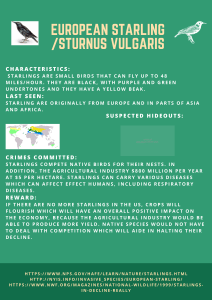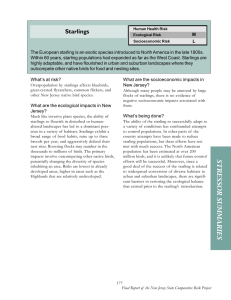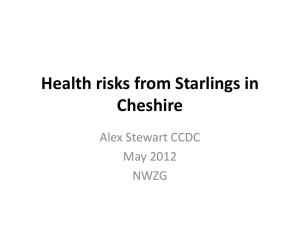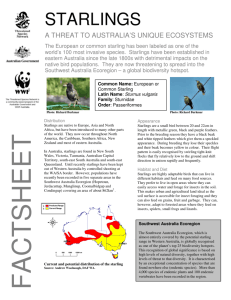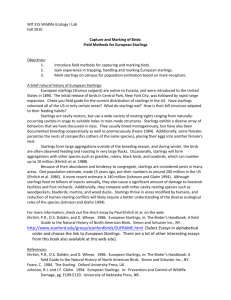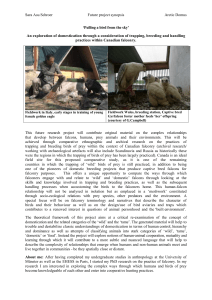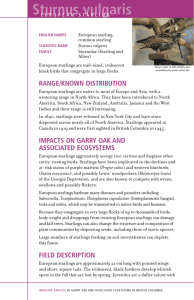Determining the Population Structure of European Starlings (Sturnus
advertisement
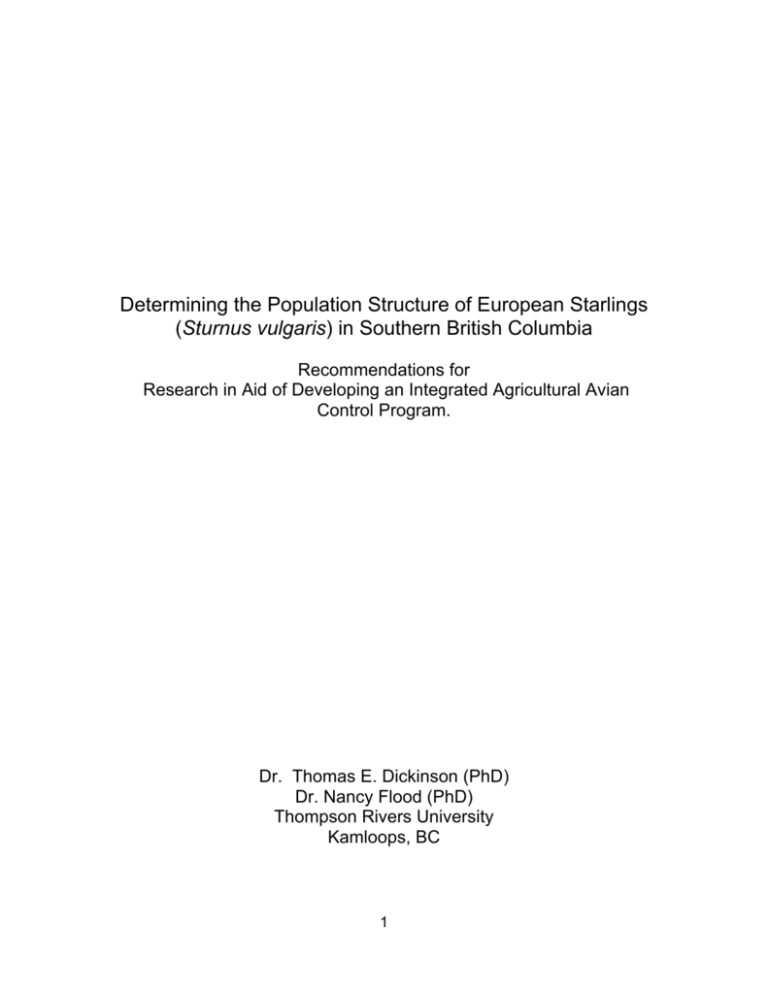
Determining the Population Structure of European Starlings (Sturnus vulgaris) in Southern British Columbia Recommendations for Research in Aid of Developing an Integrated Agricultural Avian Control Program. Dr. Thomas E. Dickinson (PhD) Dr. Nancy Flood (PhD) Thompson Rivers University Kamloops, BC 1 EXECUTIVE SUMMARY Many aspects of the reproductive biology of the European Starling (Sturnus vulgaris) permit the species to be a highly successful invasive with the capacity to cause considerable economic loss to several areas of the agriculture industry. Management programs for starlings are typically recommended to have three dimensions: the deterrence of birds from visiting the area; the protection of the crop by restricting the birds’ access to it; and controlling the population. Population control itself has two components: attempting to limit the reproductive output of the population through managing nesting opportunities and the birds’ access to food; and reducing the birds’ survival through trapping is recommended as a local solution. A five-year program to control starlings in the Okanagan region of BC has resulted in over 150 thousand birds being trapped. Trapping records show a seasonal build up of birds that likely includes locally bred individuals and migrants. Although trends in the size of the starling breeding population in BC appears to be decreasing generally, the numbers of birds overwintering in the region appear to be increasing-- further suggesting that migration is fuelling the conflicts with the agriculture industry. There is a major gap in knowledge about where the birds that make up BC’s regional populations come from and this will hamper any attempts to measure the success of control program. Understanding the structure of the population will also help determine where other control efforts will be most effective. Research recommended here will use ‘signatures’ of stable isotopes to map out geographic origins of birds in the problem areas of the province. 2 INTRODUCTION In 2003 agricultural commodity organizations with producers in the Okanagan Similkameen began a project aimed at managing the increasing losses of tree fruits, grapes and livestock feed to European Starlings (Sturnus vulgaris) throughout the Okanagan Similkameen Valleys. For example, in 2004, the economic value of crop lost mainly to starlings exceeded $3M for grapes alone and almost another $ 0.5M for other fruit. The project instigated a program of trapping birds at vineyards, feedlots, and hayfields throughout the year. Although activities occurred at several localities, much of the trapping was carried out in the southern parts of the valley. In terms of the number of starlings caught and destroyed, the program has succeeded in removing as many as 50,000 birds per year. The purpose of this proposal is to: i) briefly review the aspects of the bird’s biology that explain why it is such a successful invasive and what methods are available for its control; ii) review some of the information and summarize what has been learned during the first years of the trapping program; and iii) suggest research that would provide the information needed for the development of an integrated avian pest management program for the province. BACKGROUND European Starlings (Sturnus vulgaris) were introduced to North America in the late 19th century and currently the species can be found throughout North America, in a commensal relationship with humans and our agriculture. In North American and on other continents it has invaded, starlings have affected native wild bird species and have become reliant on agricultural production to sustain its current high population numbers. Starlings are listed on the World Conservation Union List of the World’s 100 Worst Invasive Species. The starling’s success as an invasive species is based in part on its high reproductive rate and also on its ability to exploit opportunistically abundant food sources. At lower latitudes in the United States, nesting has been recorded in every month of the year, but concentrates breeding in early-mid spring. Starlings 3 begin nesting earlier and continue nesting later than most native species. Most females raise more than one brood per season. Toward the end of the breeding season, recently fledged young are attracted to concentrations of food and gradually form increasingly large flocks. At latitudes, such as those found in throughout Canada, a portion of the population typically stays in residence year-round while, a second component of the population migrates to more temperate areas, forming roosts and foraging opportunistically as they go. These large flocks forage during the day in agricultural land and in the evening re-form assemblages in traditional roosts, often numbering in the tens to hundreds of thousands. In spring, the direction of the migration is reversed and individuals return to join the resident population; in some areas as many as 93% of the young birds produced in the previous season return to within a kilometer or two of their natal nest. Variable Nature of Economic Impacts Throughout its range, the starling has proven its potential to be an economically destructive pest. In Eastern North America, the total corn crop losses to starlings (and ‘blackbirds’) amount to only 1% of the total crop. However, because starlings forage near their roosts, the species can account for up to 10-20% in a local region. As early as the 1950’s, starlings were recognized as a severe problem in the California wine-producing region, especially Sonoma County. Because of the high dollar value of the impact on a wine grape crop, considerable attention has been paid to controlling the impact of starlings on fruit crops. In the Niagara region of Ontario, research showed that the highest crop damage occurred at field edges closest to perches such as power lines, the degree and severity of damage decreasing toward the center of the vineyard. Furthermore, it has been shown that the percentage of grapes eaten or damaged varied tremendously between areas and between years. 4 Limits of Traditional Control Methods Guidelines for starling pest control often cite the need to vary methods such as noise and visual deterrents, chemical repellents, local trapping, falconry and scare devices, such as lasers. Without coordination however, local actions can simply move the problem to a neighbor. The effectiveness of each control method, in turn, depends to a certain extent on the nature of the population that is being dealt with; resident birds will habituate to many deterrents that might be very effective against transients; conversely, in a period or region of high migration, trapping and removal of local birds could quickly be backfilled by migrants. There appears to be no ‘silver bullet when it comes to controls, but certain aspects of farm management have been found to reduce crop losses as well as the number of animals that need to be managed. In California and elsewhere, limiting nesting success locally has reduced the losses of some regions. These measures have some effectiveness if the majority of the problem is from locally bred birds. Other population control measures, killing large numbers of roosting birds have been publically criticized especially because of the high level of ‘incidental take’ of native species. The control of starlings on a continental basis is outside the sphere of influence of local activities. Depending on the nature of the population (resident vs. migrant) different control measures should be included as part of an integrated avian management plan. IS THE STARLING PROBLEM IN SOUTHERN BC CHANGING? As noted, 150, 000 starlings have been removed from the Okanagan starling population at several key locations in Keremeos, Kelowna, Oliver, Vernon, and Penticton. In some years, up to 50,000 birds have been removed. Has the abundance of starlings changed? This question is difficult to answer using the year-to-year trapping results over this period (Figure 1.) 5 Figure 1. Number of European Starlings trapped in Oliver, Keremeos, Kelowna, Vernon and Penticton. The annual capture numbers give little indication about population trends in the region. Numbers appear to vary irregularly, but even this is hard to interpret without a precise measure of the effort used to trap these birds. In order to compare the results there would have to be a similar trapping effort applied in each year or an index could be created. In this pilot program, trapping responded to problems. An alternative approach to determining whether populations had changed could be to determine whether the number of starlings monitored on a North American Breeding Bird Survey route in the region changed. The results from the Summerland route are shown in Figure 2. Figure 2. The Number of European Starlings counted on one regional BBS route. 6 Because each survey had recorded only a small number of individuals in recent years, it is hard to determine whether any upward or downward trend in the counts is significant. The low numbers likely also mean that this particular BBS route does not contain a large amount of prime starling habitat (e.g., agricultural land). Even at a different spatial scale (which should eliminate problems of habitat sampling), there is a clear indication that for BC as a whole, the size of the breeding population is declining significantly (Figure 3). Figure 3. The Average Annual Number of European Starlings Counted on all Breeding Bird Survey Routes within the Province of British Columbia. Although the size of the starling breeding population may be dropping, the size of the wintering cohort shows a clearer indication of increase. Figure 4 illustrates the changes between 1990 and 2007 in the number of starlings observed on Okanagan Christmas Bird Counts. These observations suggest that while the breeding population may be declining, the winter population is increasing, likely due to its accumulating migrants from other populations. 7 Figure 4. Standardized Christmas Counts of European Starlings in the Okanagan (courtesy of Dick Cannings) The makeup of the population in different seasons has implications for the choice of the best control strategies to be included in an integrated management plan. Figure 5 shows the number of starlings trapped in one location (Keremeos) over one year (2007), using a more-or-less constant effort. The graph shows an increase during winter and early spring months from traps positioned in feedlots. An increase in late spring and early summer represents captures of locally bred birds (near orchards) and corresponds to the ripening of cherries and apricots. A decline in August reflects a relocation of birds into hayfields where the capture success is sometimes lower. Finally the large increases during late summer and fall correspond to population increases and accumulations of birds in larger roosts at trapping sites near vineyards. (This pattern was repeated in each of the three years for which data are available.) Where the Keremeos birds come from (indeed where the birds in any location come from greatly affects the management steps that should be taken. 8 Figure 4. Monthly trapping records for starlings from one trapping area. INFORMATION GAPS AND RESEARCH RECOMMENDATIONS The industry’s goal is to develop an effective and economical integrated avian pest control program for the entire province. (Although the data were presented for the Okanagan region, the same approach will likely be applicable to anywhere in BC where starlings and agriculture interact.) In order to match the controls to the problem that requires management and, indeed, to be able to evaluate the effectiveness of control measures that are used, more information is needed on the structure of the starling population in BC than is currently available. The recommendations below aim at filling that information gap. Taken together, they define a research program that should be pursued. 9 A. Develop Capacity to Independently Monitor Starling Population Size Recommendation 1: Standardize the Collection of Trapping Data. Option • If precise records are kept of the exact locations where trapping occurs and the exact numbers of hours that traps are functionally open, trapping data can be used to develop an index of population size. Recommendation 2: Develop an Independent Survey of Starling Numbers Option • Using already established protocols for counting birds, enlist members of the different cooperating associations to track the numbers of starlings at their facilities throughout the year; • Compare the trapping numbers with monitoring results to determine whether trapping and or nest control efforts are changing the size of the breeding population on a local, sub-regional, or regional scale. B. Develop an Understanding of the Structure of BC’s Starling Populations Recommendation 3: Determine the Origins of Starlings in the Population. Option • Bird banding has been used historically to determine the source of individuals making up a population has been difficult. Large numbers of individuals are banded as nestlings and then their subsequent capture permits an idea of where individuals come from. o The mark-capture approach typically yields very low return rates for the effort involved; the source of unmarked individuals remains unknown. • Radio telemetry equipment has been used to map the movements of individuals in a population. 10 o A great deal of expense and observer time is required to monitor the spatial activity of only a small number of individuals; the approach is feasible in only a small area. • Stable Isotopes (Deuterium, Nitrogen, and Carbon) occur in different amounts and in different spatial patterns on the earth; individuals take these up and deposit them in their tissues. Recent advances at the University of Saskatchewan have been applied to problems such as the migration routes taken by (for example) songbirds, whales, and Monarch butterflies. o Feathers from captured individuals record the chemistry of the area where the feather was grown and are used in the Stable Isotope Analyses; feathers require very sample preparation to be used in analyses; o By knowing the isotopic signature of local sub-populations and getting reference points from other regions within BC, a library of signatures should be possible. o Young of the year starlings captured in the destination region can then be matched to the source population from which it came. o Dr. Keith Hobson developed this field of applying Stable Isotope Analysis to wildlife and is interested in collaborating on this project; o The NRC IRAP program has expressed interest in applying this technology to solve an industry problem; o Discussions are underway with the administration at PARC in Summerland to provide logistical support for the project o An NSERC Industrial Graduate Scholarship would be available to a qualified MSc student to carry out research over a two-year time frame. Filling of the information gaps should begin immediately by coordinating the recording of data by trappers. In addition, feather samples should start being collected as part of the standard trapping procedures. 11 Research Budget (2008-2009): Revenue NSERC Industrial Graduate Fellowship $15,000 Industry Consortium 8,500 Agriculture Environment Partnership Initiative 7,500 NRC IRAP 5,000 $36,000 Expenses Graduate Student (MSc) Fellowship $21,000 Fieldwork (travel, assistance, etc) 10,000 Lab work (sample prep and analysis—100@ $50) 5,000 $36,000 12
